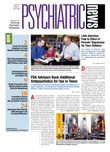An 18-member advisory committee of the Food and Drug Administration (FDA) voted in June to recommend the approvals of quetiapine and olanzapine for treating schizophrenia and bipolar manic episodes in teenagers. Their opinions on whether ziprasidone should be approved to treat young patients with bipolar mania, however, were mixed.
Two other second-generation antipsychotics (SGAs), risperidone and aripiprazole, have previously been approved for treating schizophrenia in patients aged 13 to 17 and bipolar disorder in patients aged 10 to 17.
Quetiapine received the most consistent support from the committee, with a vast majority voting “yes” on the four questions pertaining to the drug's effectiveness and safety for both indications. Its manufacturer, AstraZeneca, had conducted a six-week, randomized, placebo-controlled, double-blind clinical trial of the drug in patients with schizophrenia aged 13 to 17 and a three-week trial in patients aged 10 to 17 who were experiencing a current bipolar manic episode.
The advisory committee, which met at a public hearing June 10, had a more mixed response to Pfizer's data on ziprasidone to treat bipolar mania in patients aged 10 to 17. In a four-week, randomized, placebo-controlled trial, the drug outperformed placebo in efficacy endpoints overall. However, subgroups of younger patients aged 10 to 14 and patients weighing less than 45 kg did not achieve statistically significant difference between ziprasidone and placebo, and the small numbers of patients in these subgroups precluded any meaningful conclusion. The committee gave 12 votes of “yes,” two votes of “no,” and four abstentions on the question of ziprasidone's efficacy.
Ziprasidone's safety profile caused further concerns because of its well-established association with QTc interval prolongation in children, adolescents, and adults, which is currently described in the product label. The drug received only eight votes supporting its safety, with one vote of“ no” and nine abstentions.
Olanzapine also caused much debate among committee members because of its potentially serious and long-lasting adverse effects, including weight gain, metabolic abnormalities, and prolactin increase. Eli Lilly submitted applications to the FDA seeking pediatric indications for olanzapine as early as October 2006 and has received conditional approvable letters twice since. However, the approval has remained pending as adverse-event reports increased over the past few years.
Thomas Laughren, M.D., director of the FDA's Division of Psychiatry Products, told the advisory committee that should olanzapine be approved for pediatric and adolescent indications, the agency plans to require wording on the product label recommending that physicians try other treatment options before olanzapine. A company representative also assured the committee that extensive postmarketing risk evaluation and management programs would be implemented.
Olanzapine's efficacy received support from the committee, but nearly half of the committee members expressed reservations about its safety by voting“ no” or abstaining on the questions of whether olanzapine is acceptably safe for the treatment of schizophrenia and bipolar disorder in patients aged 13 to 17.
This cross-specialty advisory committee consisted of members from the FDA's psychopharmacologic drugs, pediatric, cardiovascular and renal drugs, drug safety and risk management, and endocrinologic and metabolic drugs advisory committees.
During the open public hearing, David Fassler, M.D., APA secretary-treasurer and a child and adolescent psychiatrist, urged the FDA to“ consider the reality of how medications are used in the treatment of children and adolescents with complex psychiatric disorders ... and to limit any specific indication approval to short-term, episodic use consistent with the data presented.” He also recommended that the FDA require the companies that make the SGAs to conduct phase-4 trials to evaluate long-term outcomes associated with these drugs. Fassler was testifying on behalf of APA.
Laurence Greenhill, M.D., president of the American Academy of Child and Adolescent Psychiatry, also spoke at the public hearing. He urged the FDA to require a registry for the use of these antipsychotics in children and adolescents so that more long-term data on the safety and efficacy can be centrally collected and monitored. Currently, a national registry is in place for clozapine use because of its potentially fatal side effect.
While these SGAs await the FDA's decision about their use in pediatric patients, they are already often prescribed off-label for pediatric and adolescent patients with schizophrenia, bipolar disorder, and other conditions. The approvals, however, could open the door for the companies to market these indications in younger patients directly to consumers and prescribers.
Also in their testimony, both Fassler and Greenhill asked the FDA to consider ways to control direct-to-consumer (DTC) advertising, because if the SGAs do receive FDA approval, it could create a perception that these drugs are safe and effective for long-term use in children and adolescents.
“I urge you to consider recommending a moratorium on DTC advertising for a period of time following FDA approval of any specific indications currently under consideration,” said Fassler. This “may be particularly appropriate for medications such as the atypical antipsychotics for which there is general agreement that we don't yet have sufficient data on long-term safety and efficacy in the pediatric population.” ▪
